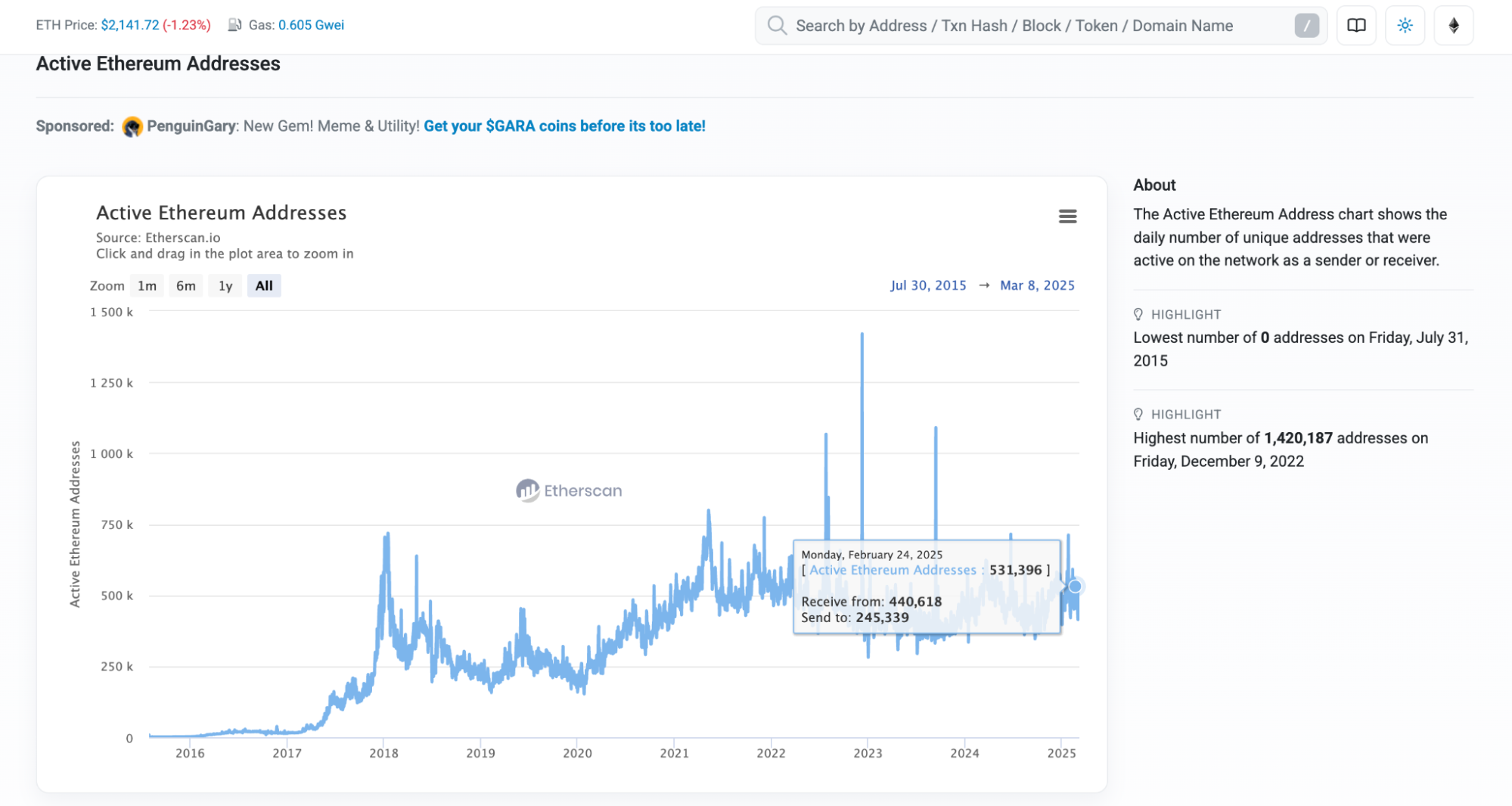Mar 3, 2025
4 min read

An active address in cryptocurrency refers to an address (public key) that has been used to send or receive transactions within a given time frame. It's a way to track user activity on a blockchain. For example:
Tracking active addresses helps measure the usage and adoption of a cryptocurrency. For instance, if a cryptocurrency network consistently has a high number of active addresses, it may indicate a growing user base or increasing network activity.
These metrics are often used by analysts and investors to gauge the health and growth of a blockchain network or the overall ecosystem.
Investors and researchers mainly track 3 types of active addresses depending on the timeframe of activity. These are
Daily Active Addresses
These are the total number of addresses on the blockchain that have either received or sent funds in the last 24hrs. The metric is sometimes referred to as Daily Active Users. Addresses that are active daily are usually associated with traders who are highly active on DEXs, market makers, gamers and metaverse players, and smart contract programs that deploy and operate automatically.
Weekly Active Addresses
These are the total number of addresses on the blockchain that have either received or sent funds in the last 7 days. The metric is sometimes referred to as Weekly Active Users.
Monthly Active Addresses
These are the total number of addresses on the blockchain that have either received or sent funds in the last 1 month. The metric is sometimes referred to as Monthly Active Users.
Let’s take an example of the Ethereum Blockchain and refer to the data on Etherscan to understand how active addresses are calculated.

On Feb 24, 2025 the number of Active Ethereum Addresses was 531,396. 440,618 addresses received some funds, while 245,339 addresses sent funds. Some addresses that received funds could have also sent funds. Hence, it is important to only count the unique addresses. For addresses that both sent and received funds, it will be calculated as a single active address.
The same mechanism can be used to calculate weekly and monthly active addresses. In order to calculate active addresses, we will only require the entire transaction history for the blockchain in a specific time period - daily, weekly or monthly and then count the unique addresses only.
Daily Active Users and Daily Active Addresses are not exactly the same. A user on blockchain can have multiple addresses with which he or she can transact. Hence Addresses cannot be mapped to Users 1:1. Some blockchain developer teams might create thousands of addresses and multiple transactions among them to paint a false image that the adoption and activity on the blockchain is high. Hence, while analysing a blockchain, active addresses must not be the only criteria. ICR scoring ensures many parameters such as TVL, Fees and Revenue, NVT ratio and Liquidity score is considered while scoring and ranking a crypto algorithm.
Navigate to any crypto on the ICR platform and select “Our Analysis” to check out historical data for Daily, Weekly and Monthly Active Users for any of your favourite coins.

Active addresses serve as a crucial metric for evaluating the usage and adoption of a blockchain network. By analysing daily, weekly, and monthly active addresses, investors can gain insights into transaction activity, network health, and potential growth trends. However, it’s important to recognise that active addresses do not directly equate to active users, as one individual or entity may control multiple addresses. For a more comprehensive analysis, additional metrics such as Total Value Locked (TVL), Fees and Revenue, NVT Ratio, and Liquidity Score should also be considered.
What are active addresses?
Active addresses refer to unique cryptocurrency wallet addresses that participate in a successful transaction, either as a sender or a receiver, within a specific timeframe. These transactions are recorded on the blockchain (on-chain transactions). Each address is counted only once within the given timeframe, even if it is involved in multiple transactions
What is an active address indicator?
The active address indicator measures the number of unique wallet addresses actively participating in transactions on a blockchain network during a specific period. It is used to assess network activity, user engagement, and adoption trends. A rise in active addresses often signals increased interest, usage, or market activity for a cryptocurrency
How many active addresses are there in Bitcoin?
As of March 19, 2025, Bitcoin's network had over 536,090 active addresses in a single day. Check out our Bitcoin Analysis page for live data
Are active addresses the same as active users?
No, active addresses and active users are different. A single user can control multiple addresses, and some blockchain projects may generate artificial transactions to inflate activity.
Why are active addresses an important metric?
Active addresses help measure blockchain network activity, user engagement, and adoption trends. A rising number of active addresses often indicates increasing interest and growth in a cryptocurrency.
How can I track active addresses for a cryptocurrency?
You can track active addresses using blockchain explorers like Etherscan (Ethereum), or platforms like India Crypto Research (ICR), which provide historical data on active addresses.
The information provided in this blog is based on publicly available information and is intended solely for personal information, awareness, and educational purposes and should not be considered as financial advice or a recommendation for investment decisions. We have attempted to provide accurate and factual information, but we cannot guarantee that the data is timely, accurate, or complete. 1 Finance Private Limited or any of its representatives will not be liable or responsible for any losses or damages incurred by the Readers as a result of this blog. Readers of this blog should rely on their own investigations and take their own professional advice.